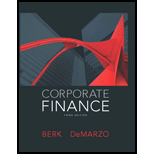
Explain some of the differences between a public debt offering and a private debt offering.
To discuss: The difference between a public debt offering and a private debt offering.
Introduction: Debt offering happens when a company issues debt; it is basically a loan from an investor who purchases deb. The investor receives a promise or commitment that the debt issuer will pay some type of interest to the debt holder and, at a later date, pay back the principal payment to the investor.
Explanation of Solution
The difference between a public debt offering and a private debt offering is as follows:
A private debt offering is held in private to a select group of investors. Since the bonds are not public, the financial information is not required to be published and they do not require a credit rating. On the other hand, public debt offering is where a company publicizes their upcoming debt offering information like date, time, place and various types of security offerings to the public and potential investors. Financial information must be published annually to the public for a public debt offering. These public debt offerings are very competitive, so it requires credit rating in order for the investor to easily understand the debt creditworthiness of the public debt offering.
Want to see more full solutions like this?
Chapter 24 Solutions
Corporate Finance
Additional Business Textbook Solutions
Business Essentials (12th Edition) (What's New in Intro to Business)
Auditing And Assurance Services
Gitman: Principl Manageri Finance_15 (15th Edition) (What's New in Finance)
Operations Management
Marketing: An Introduction (13th Edition)
Horngren's Cost Accounting: A Managerial Emphasis (16th Edition)
- An accounts payable period decrease would increase the length of a firm's cash cycle. Consider each in isolation. Question 6 options: True Falsearrow_forwardWhich of the following is the best definition of cash budget? Question 10 options: Costs that rise with increases in the level of investment in current assets. A forecast of cash receipts and disbursements for the next planning period. A secured short-term loan that involves either the assignment or factoring of the receivable. The time between sale of inventory and collection of the receivable. The time between receipt of inventory and payment for it.arrow_forwardShort-term financial decisions are typically defined to include cash inflows and outflows that occur within __ year(s) or less. Question 9 options: Four Two Three Five Onearrow_forward
- A national firm has sales of $575,000 and cost of goods sold of $368,000. At the beginning of the year, the inventory was $42,000. At the end of the year, the inventory balance was $45,000. What is the inventory turnover rate? Question 8 options: 8.46 times 13.22 times 43.14 times 12.78 times 28.56 timesarrow_forwardThe formula (Cash cycle + accounts payable period) correctly defines the operating cycle. Question 7 options: False Truearrow_forwardAn accounts payable period decrease would increase the length of a firm's cash cycle. Consider each in isolation. Question 6 options: True Falsearrow_forward
- Which of the following issues is/are NOT considered a part of short-term finance? Question 5 options: The amount of credit that should be extended to customers The firm determining whether to issue commercial paper or obtain a bank loan The amount of the firms current income that should be paid out as dividends The amount the firm should borrow short-term A reasonable level of cash for the firm to maintainarrow_forwardLiberal credit terms for customers is associated with a restrictive short-term financial policy. Question 3 options: True Falsearrow_forwardAn increase in fixed assets is a source of cash. Question 2 options: True Falsearrow_forward
- If the initial current ratio for a firm is greater than one, then using cash to purchase marketable securities will decrease net working capital. True or falsearrow_forwardwhat is going to be the value of American put option that expires in one year modeled with a binomial tree of 3 months step with year to expiry? assume the underlying is oil future with RF of 5% and vol of oil is 30%. Strike is 70 and price is 60 of oil. 13.68 13.44 13.01arrow_forwardhello tutor need step by step approach.arrow_forward
 EBK CONTEMPORARY FINANCIAL MANAGEMENTFinanceISBN:9781337514835Author:MOYERPublisher:CENGAGE LEARNING - CONSIGNMENT
EBK CONTEMPORARY FINANCIAL MANAGEMENTFinanceISBN:9781337514835Author:MOYERPublisher:CENGAGE LEARNING - CONSIGNMENT Intermediate Financial Management (MindTap Course...FinanceISBN:9781337395083Author:Eugene F. Brigham, Phillip R. DavesPublisher:Cengage Learning
Intermediate Financial Management (MindTap Course...FinanceISBN:9781337395083Author:Eugene F. Brigham, Phillip R. DavesPublisher:Cengage Learning- Principles of Accounting Volume 1AccountingISBN:9781947172685Author:OpenStaxPublisher:OpenStax College





